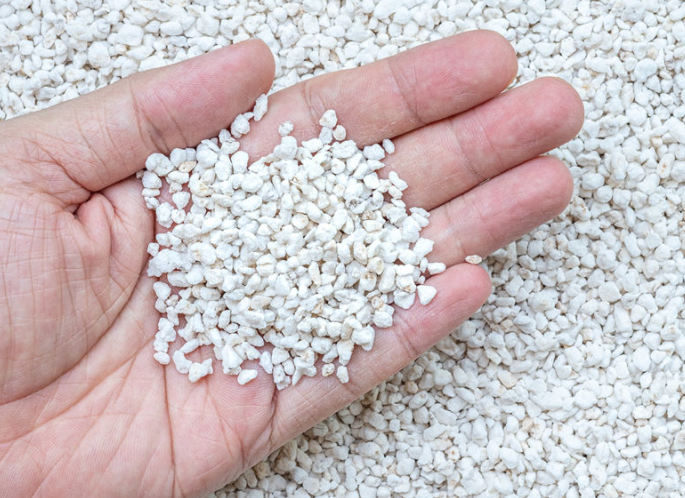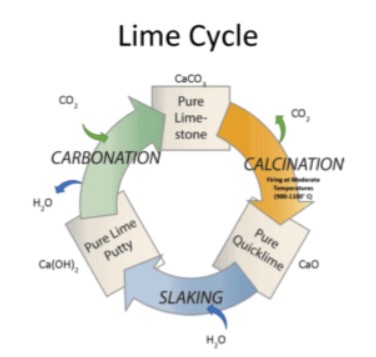Perlite is not a household name…but it’s in a lot of products you might not know about, such as insulation, filters and even cosmetics. First, let’s look at what perlite is and where it comes from.
Perlite is a volcanic rock that’s closely related to pumice–that rough one with all the holes, used for scraping calluses off your feet or stains off the toilet. Perlite ore (raw form) is a pearly white color (“perle” is the french word for pearl) that has a low density (it’s lightweight) and relatively low price on the market (about US$150 per tonne of unexpanded perlite) due to its relative abundance. “Unexpanded” is its natural state; “expanded” is the manufacturing process that heats perlite until it “pops” like popcorn due to the water content inside the rock. Natural perlite is first crushed to the desired size granules, then heated. Because natural perlite has a relatively high water content of 2-5%, when it is heated, the water turns to steam, which explodes and opens up the pores in the rock, also turning the rock into small pebble-like fragments that resemble styrofoam balls. (Perlite) These are the little white balls you most often see in potting soil. The “expanded” perlite is now even less dense, very porous, and can hold even more water. Expanded perlite has 70 times more surface area and pore volume compared to unexpanded perlite (Hydrogen Storage in Expanded Perlite), which is similar to another material you may be more familiar with, activated carbon.
Perlite enhances plant soil because it provides many small water storage chambers that slowly release water so that plants can endure dry spells. It can also increase drainage in clay-type soils. Besides potting soil, though, what are scientists and researchers doing with perlite?
Perlite for insulation
For wall insulation, perlite can be poured or blown into the wall cavities. Make sure the perlite is spread out evenly and fills all spaces to work best at keeping things insulated. Special tools can spread perlite evenly in wall spaces. Make sure there are no empty spaces. Empty spaces can make the insulation less effective. After adding insulation perlite, be sure to seal the area tightly to prevent it from moving or compacting. You can do this by using a vapor barrier or sealant. Sealing perlite stops it from moving and makes it better at keeping heat and moisture out. This step is very important to keep the insulation working well for a long time. Perlite can be used in residential, commercial and industrial construction. The little grains of perlite are filled with air pockets, so it’s essentially doing what other air-filled insulation products do by using air to insulate your walls. Since it’s naturally fire-resistant, it stops flames from spreading, making the building safer during a fire. It gives everyone more time to get out safely. (Expert Tips: Using Perlite for Insulation in Construction!)
Spray foam insulation is petroleum based and over time will deteriorate, melt and ultimately end up as petroleum goo in landfills. Wanting no part of that, our eco-friendly clients across industries have been switching to loose-fill perlite insulation, which is all natural and will never deteriorate. It also has better R-Values and is more cost-effective than spray foam. (Success Stories)
Perlite as a mineral adsorbent for heavy metals ions and dye removal from industrial wastewater
Studies have shown that perlite-based adsorbents can achieve high removal efficiencies for pollutants, making it an attractive option for water treatment applications. Its low cost, abundance, and ease of preparation also make it a sustainable and eco-friendly alternative to other adsorbents.
Perlite for Filtration
Perlite can be sprayed onto filters to increase their filter efficiency. It’s termed a “filter aid” because it effectively increases the “surface area” of the filter and increases its use time and contaminant capture before it clogs. These functions make it useful in industrial dust filters, for one. However, since perlite is lightweight, inert, imparts no taste or odor to liquids being filtered, and is virtually insoluble in mineral and organic acids at all temperatures, it’s even used in food-grade filters like juices, beers, wines, sweeteners, vegetable oils. Here are some other industries that use it:
Pharmaceuticals: enzymes, antibiotics, Epsom salt
Industrial: water treatment, sizings, oil & solvent recovery, greases
Chemicals: inorganic & organic chemicals, resins, polymers, brine, adhesives, fertilizers, waste disposal
Paint and Coatings: waxes, oils, varnish, gums, shellac, wastewater treatment
Environmental: stormwater filtration, ecology embankments, media filter drains
Perlite as a Cement Additive
When added to cement, perlite helps create a mix that is lighter, stronger, and better at insulating. Whether you’re building walls, floors, or panels, using perlite for cement can make your project more efficient and cost-effective. Perlite cement can resist changes in temperature and moisture, which makes it last longer. It doesn’t break as easily as regular cement, making it great for places with harsh weather. Cement mixed with perlite is also fire-resistant. Perlite cement can handle high temperatures, which makes it ideal for projects that need extra fire protection. Bulk perlite is added slowly to the wet cement mix; a common ratio is about 1 part perlite to 6 parts cement by volume. The amount of perlite can be adjusted based on how lightweight or insulating you want the mix to be.
Perlite as Moisture Control
Perlite is a cheap way to control moisture. It’s effective and cheaper than other drying agents. Perlite can absorb up to four times its weight in water, depending on the grade and particle size. In order to guard against moisture intrusion and maintain the quality of pharmaceutical products, companies use perlite in the following ways:
One popular way to use bulk perlite in the pharma industry is in packaging. Manufacturers keep tablets, capsules, and powders dry and stable by including perlite in desiccant packs or the packaging. This keeps their quality good, even if the environment changes.
Bulk perlite is often used in storage places for medicines before they are sent out. Keeping the right amount of moisture in big storage places is crucial to protect items. Perlite helps pharma products stay dry and in good shape while stored.
Perlite can even be used in direct contact with bulk products because it’s inert and non-toxic.
Perlite in Animal Husbandry
Because perlite is inert and non-toxic, it has been widely studied in animals and deemed safe for ingestion. It can be used as a carrier of liquid vitamins or drugs for livestock. Perlite impregnated with medicine is added to animal feed. The perlite medicine is gradually released in the animal’s body, but the perlite itself remains excreted. Perlite is also added to feed as a natural anti-caking agent. Because it adsorbs moisture, it acts to prevent mold in feed. It has also been used as an odor and moisture absorber in animal bedding. (The Use of Perlite)
Other applications (The Use of Perlite):
Cat litter
Acoustic insulation
Scent carrier (for scented products)
Cosmetics
Abrasive and polishing agents
Absorbent bales and booms for oil and chemical spills
So, the next time you see bags of perlite in the garden department, you might think outside the garden and pick up a bag or two for spill cleanup, odor control in the hamster or bird cage, cement additive, or any other project where you can use its unique properties.








